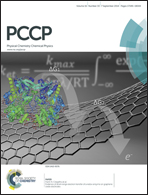Loading of ionic compounds into metal–organic frameworks: a joint theoretical and experimental study for the case of La3+†
Abstract
Crystalline, highly orientated surface-anchored MOF thin films, grown on Au substrates, were prepared using liquid-phase epitaxy (LPE). The successful loading of La3+ ions into the Cu3(BTC)2 (HKUST-1) SURMOFs (surface-mounted metal–organic frameworks) was monitored using X-ray diffraction (XRD). Theoretical calculations using classical force-field based Monte Carlo simulations yield a structure with two La3+ ions within the large Cu3(BTC)2 pores, in full agreement with experimental results on the composition of these films and the relative intensities of the XRD peaks. Implications of these findings for using MOF thin films for electronic applications are briefly discussed.


 Please wait while we load your content...
Please wait while we load your content...